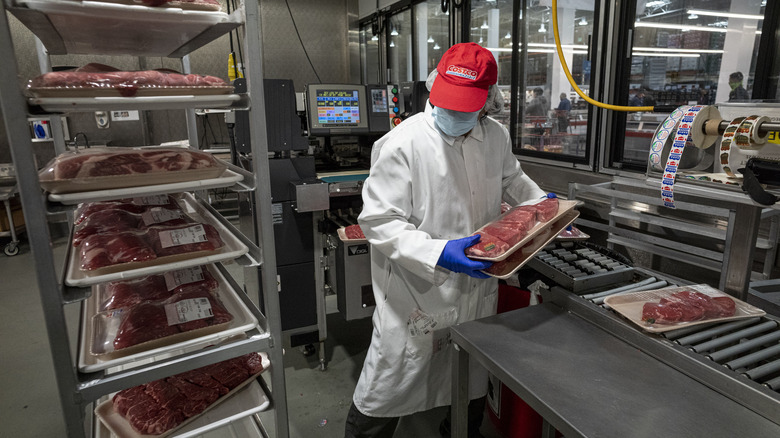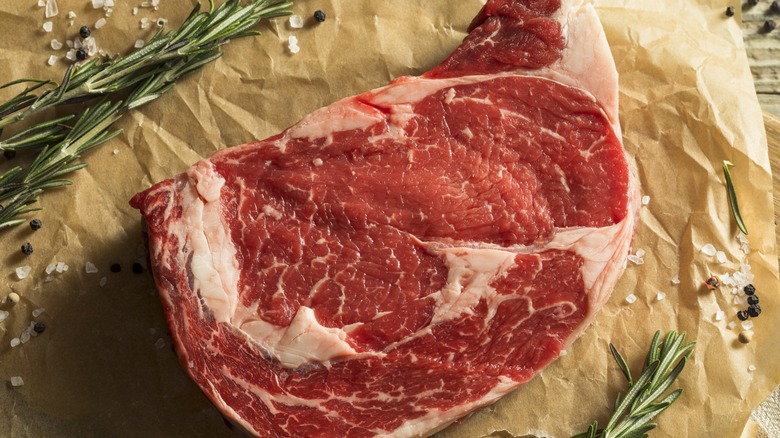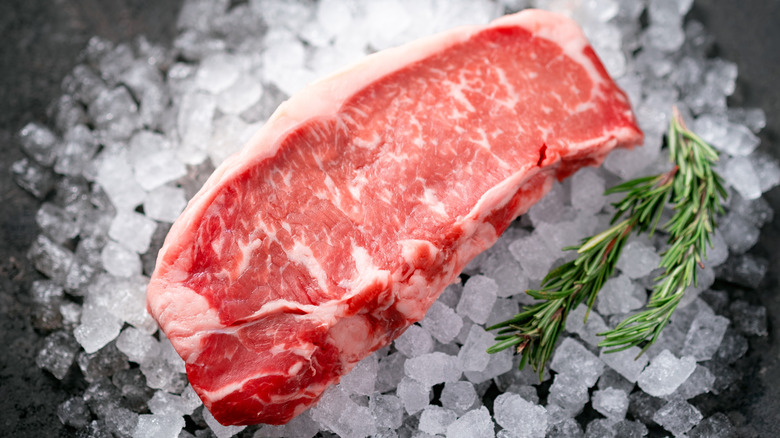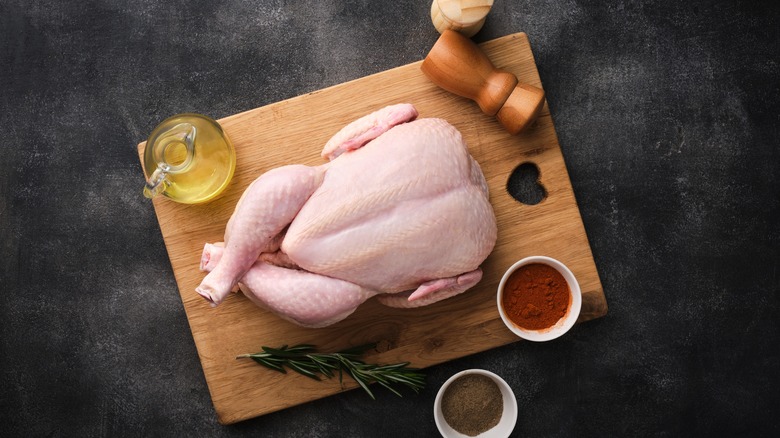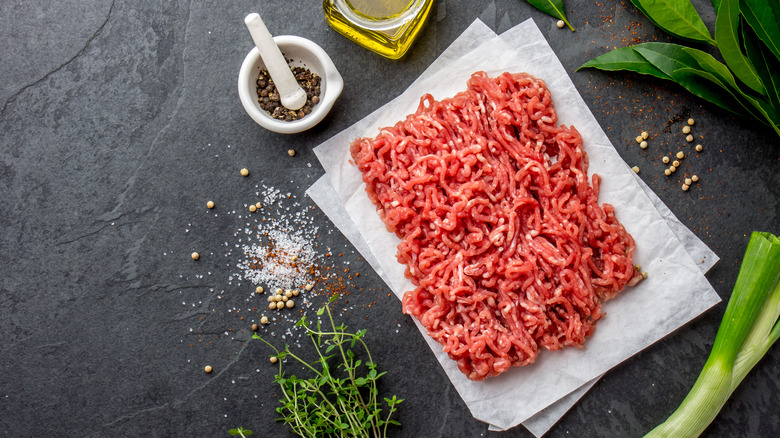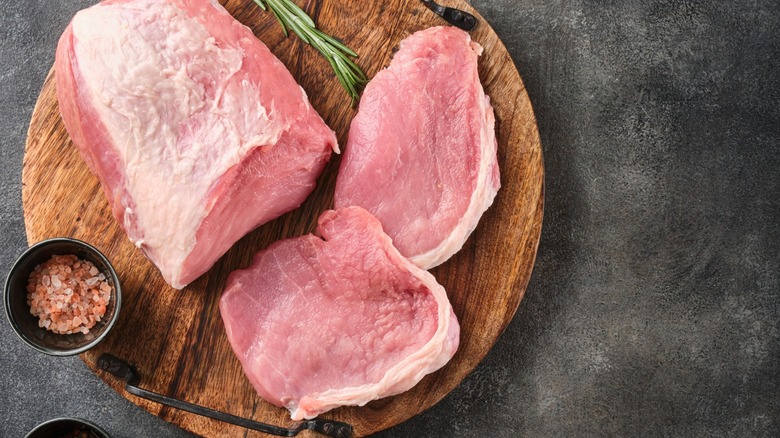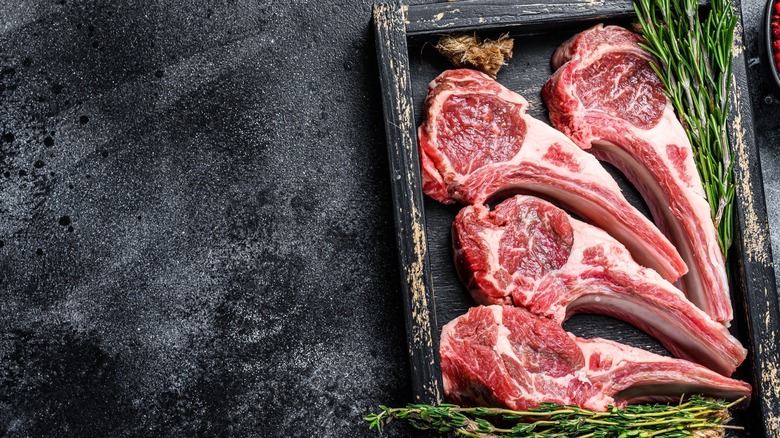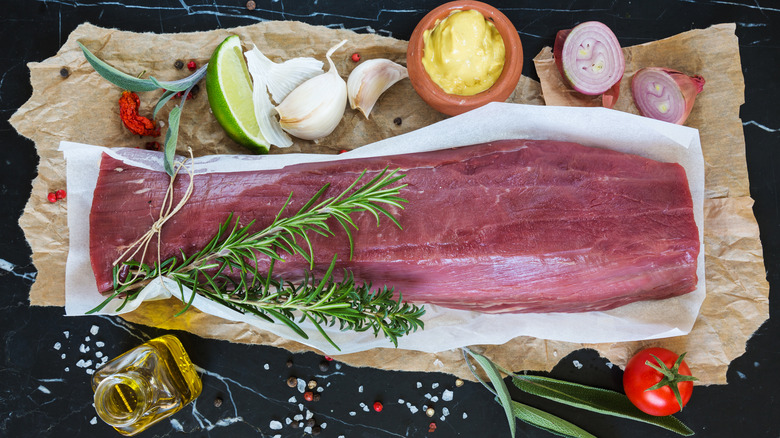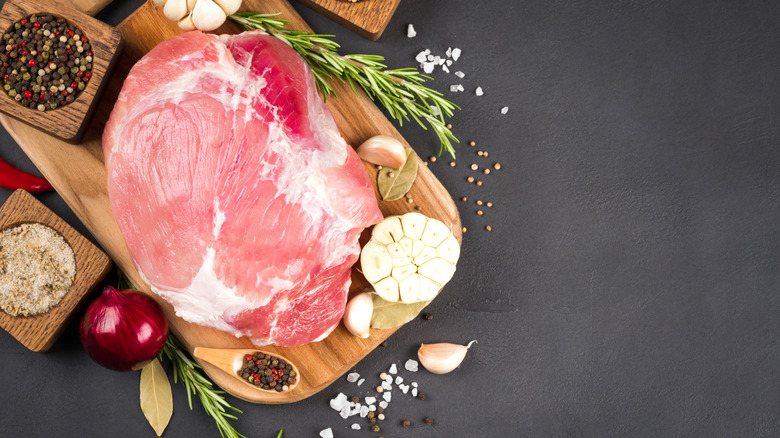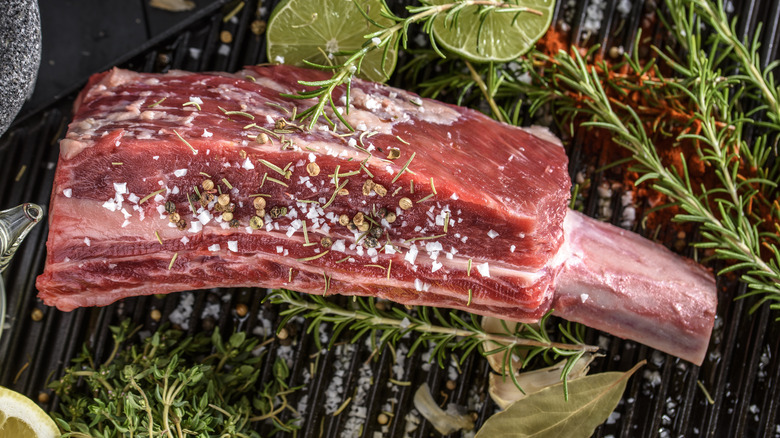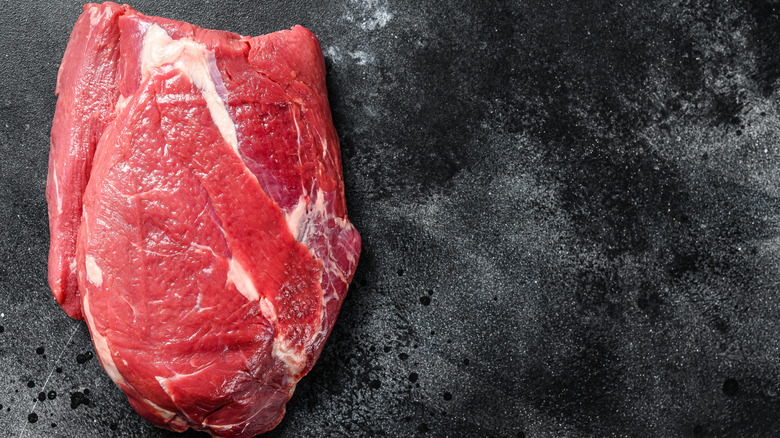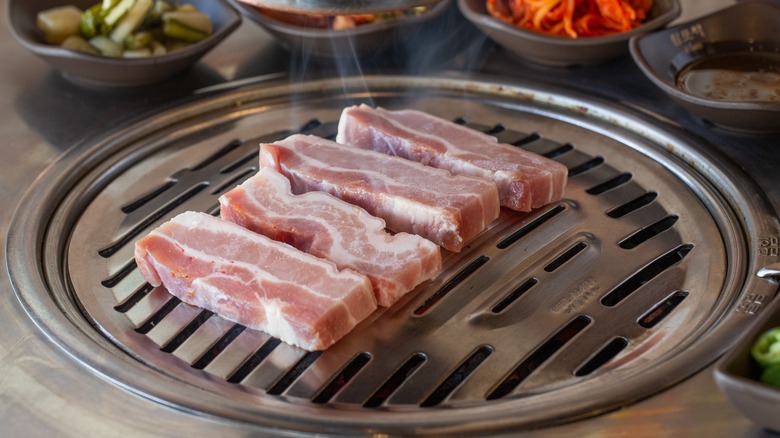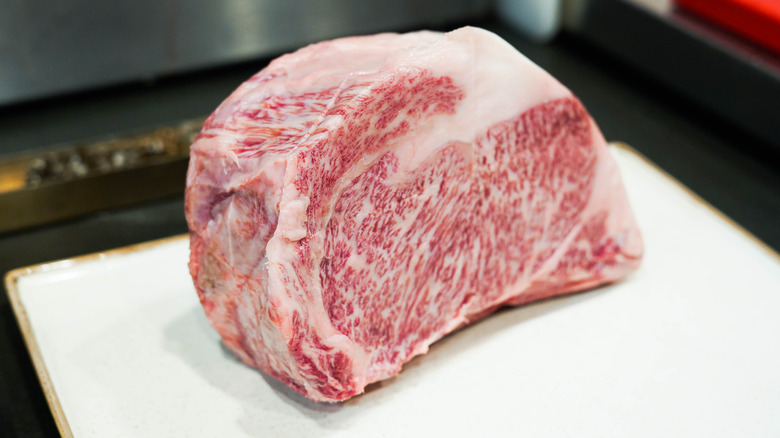12 Meats You Shouldn't Pass On At The Costco Butcher Counter
Costco's butcher counter is a haven for meat enthusiasts, seamlessly blending quality with variety. Amidst the wide-ranging offerings of the store, it stands as a testament to Costco's commitment to bringing its customers top-tier produce at great value. Each meat cut available, from the everyday essentials to the gourmet luxuries, has a story, a place of origin, and a range of culinary possibilities. The store's selection offers a unique blend of traditional favorites and international delicacies, meeting the expectations of both the home cook and the adventurous eater.
Navigating the vast selection can be both exciting and overwhelming, with choices like the luxurious Japanese A5 Wagyu standing alongside staples like the succulent rack of lamb and the versatile whole chicken. How do these meats fit into your dinner plans or special occasions? Perhaps you're familiar with the aromatic allure of lamb or have roasted a chicken, but have you explored its full potential in diverse culinary traditions? With numerous options available, it becomes a playground for those eager to experiment with different recipes and flavors.
1. Prime Beef Ribeye Steaks
Ribeye is often prized for its rich, beefy flavor and the high degree of marbling that runs throughout the meat. The generous fat distribution is mainly concentrated in the cap, or outer rim, which is renowned for its tenderness and flavor; it is sometimes even sold individually as rolled steak. Meanwhile, the center cut or eye offers a leaner, yet still tender, texture. The ribeye is commonly grilled or pan-seared to develop a caramelized crust. Because of the steak's inherent richness, it is often enjoyed with minimal seasoning — typically just salt and pepper. The USDA Prime rating signifies that these ribeye steaks meet stringent quality criteria, including superior marbling, thereby enhancing their tenderness, juiciness, and flavor.
At Costco, mechanical tenderization, commonly known as blade-tenderizing, is employed to enhance the meat's tenderness. Although this process generally makes the steak more palatable, it also carries the potential risk of introducing surface bacteria into the interior of the meat. According to insights shared on a Reddit thread by a Meat Department Supervisor at Costco, the company adheres to USDA guidelines by cleaning the blade-tenderizing machinery every four hours to minimize the risk of bacterial contamination. A common workaround for this concern is to purchase a whole, non-tenderized primal cut and portion it yourself.
2. Prime New York Strip
Traditionally featured in upscale steakhouses, the Prime New York Strip is celebrated for its well-balanced profile—less fatty than a ribeye but more marbled than a sirloin. This versatile meat excels whether grilled, broiled, or pan-seared. The strip of fat running along one edge is a point of debate: some welcome the extra flavor, while others may find it off-putting, often due to dietary preferences. If you belong to the former group, consider rendering down the fat edge by searing it first, a technique known to maximize flavor.
The prime strip pairs well with a variety of sides, from classic baked potatoes to Caesar salad. A robust wine like Cabernet Sauvignon can serve as a fitting counterbalance to the steak's richness. Sauces such as béarnaise or simple garlic butter can also complement the meat without overwhelming it. At Costco, the New York strip, like their ribeye steaks, undergoes mechanical tenderization. To avoid this, consider purchasing a whole, non-tenderized primal cut. For those who opt for the tenderized version, the USDA recommends cooking the meat to an internal temperature of 145 degrees Fahrenheit and allowing it to rest for three minutes before consumption.
3. Organic Whole Chickens
Costco's organic whole chickens typically come at a competitive price per pound compared to other retailers. Unlike the store's famous seasoned rotisserie chickens, which are often high in sodium and contain additives like carrageenan and phosphates, organic whole chickens are raised without antibiotics and fed organic, non-GMO feed. This not only minimizes exposure to potentially harmful chemicals but also mitigates the broader public health issue of antibiotic resistance, as detailed in a study from Environmental Health Perspectives. USDA guidelines also mandate that if a bird becomes ill and requires antibiotics, it must be treated, but its meat can no longer be sold as organic.
Buying a whole chicken also gives you the flexibility to experiment with different recipes, whether you prefer a simple roast with herbs or complex dishes like chicken tikka masala. Any leftover meat can also be utilized for making chicken salad, casseroles, or pot pies. Additionally, the bones can be used to create broth for soups and risottos.
4. Ground bison
For health-conscious consumers, ground bison is a compelling choice as it typically contains fewer calories and less fat than conventional ground beef. It is also rich in essential nutrients like protein, which is essential for muscle growth and repair; iron, which supports blood health; and Vitamin B12, essential for nerve function, according to Healthline. At Costco, it's commonly available from brands like Northfork and Noble.
Ground bison is suitable for various dishes, such as bison burgers, chili, meatballs, and even bolognese sauce. Taste-wise, while it may initially emit a gamey aroma during cooking, it lacks the gamey flavor often associated with wild meats, offering a subtle, sweet undertone instead when eaten. However, some people might still find it gamey; for that reason, try using mustard to make it more palatable. Its texture is somewhat coarser than that of most ground beef due to its lower fat. This lean profile also means it cooks more quickly and is less likely to splatter in the oven.
5. Boneless pork loin
Boneless pork loin from Costco is a value-driven purchase, as it is sold in a whole loin at a lower cost per pound compared to buying individual chops. This bulk availability makes it convenient for meal planning and batch cooking. Furthermore, this cut of meat stands out for its nutritional profile, being leaner than other pork options like pork shoulder or belly. It offers a healthier alternative without compromising on essential nutrients such as protein, B vitamins, and zinc, according to Coleman Natural Foods.
Pork loin's lean profile lends itself to multiple cooking methods, such as roasting, grilling, and deep frying. In particular, its suitability for deep frying makes it a popular choice in Cantonese and Hong Kong-style dishes like salt and pepper pork chops. Its shorter cooking times make it convenient for weeknight dinners. The boneless cut ensures even heat distribution, while its mild flavor pairs well with various seasonings and marinades, from essential salt and herb rubs to elaborate sauces like hoisin or chimichurri.
6. Australian lamb racks
There's little reason to pass up Australian lamb racks the next time you're at Costco. They represent a culinary luxury offered at an accessible price point, ideal for those looking to elevate their dinner experiences. Lamb is a known source of omega-3 fatty acids, which, according to MedlinePlus, support heart health by reducing triglycerides. Additionally, lamb contains conjugated linoleic acid, a type of fatty acid that WebMD states can boost immune functions. Costco sells these lamb racks under its Kirkland Signature brand, and they come already frenched and Halal-certified.
While lamb is often cited for its distinct aroma, which some find off-putting, marinating the meat in acidic ingredients like lemon juice or vinegar, coupled with aromatic herbs such as rosemary and thyme, can help neutralize the odor without compromising its natural flavors. Cooking this cut is straightforward; it can be roasted, grilled, or slow-cooked. Whether you opt for a classic recipe like an herb-crusted rack of lamb or venture into something more adventurous like a Moroccan-spiced lamb rack, the meat is sure to shine.
7. Beef tenderloin
Recognized for its unrivaled soft buttery texture, beef tenderloin emerges as an indispensable option for those aiming to bring gourmet dining into their homes. This premium cut is a stellar choice for creating dishes like the classic stroganoff, enriched with a creamy mushroom sauce, or beef wellington that showcases a golden, flaky pastry crust. When selecting the grade at Costco, opting for the prime variant is advisable. Despite its higher price point, it promises a substantial return on investment, enriching dishes with intensified flavor and an exceptionally tender texture due to increased marbling.
The whole tenderloin offers several distinct sections, each holding its unique appeal. The smaller end, known as the tail, can be utilized in stews or stir-fries. The center-cut portion, which can be sliced into filet mignon steaks, proves exceptional when grilled or pan-seared. Progressing towards the larger end is the chateaubriand, a thick cut that is perfect for roasting. Another prized segment is the tournedos, medallion-like slices that become the star of dishes accompanied by rich sauces.
8. Pork Shoulder Butt
The pork shoulder butt, alternatively known as the Boston butt, is extracted from the upper portion of the pig's shoulder, a detail esteemed by chefs and home cooks alike for its meaty richness and culinary versatility. Contrary to what the name might suggest, the term butt doesn't allude to the animal's hindquarters; it has its roots in an old English word that denotes the barrels historically used to store meats. This cut distinguishes itself through its well-marbled flesh, lending it a remarkable flavor and succulence.
This section of the pork frequently emerges as a prime selection for various slow-cooked dishes. Its considerable collagen content diminishes through extended cooking periods, giving way to a tender, melt-in-your-mouth texture, a quality highly prized in dishes such as pulled pork. The natural fat content aids in retaining moisture, warding off dryness throughout the cooking process and establishing it as a preferred option for barbecues and roasts. Furthermore, it is favored for sausage production due to an optimal meat-to-fat ratio that guarantees succulent and tasty results. In terms of seasoning, this cut harmonizes well with apple and maple syrup combo or herbs like thyme and rosemary.
9. Prime Bone-in Beef Short Ribs
The USDA Prime Beef Bone-In Short Ribs available at Costco represent a premium choice for connoisseurs of fine meats, finding a place at dining tables in diverse culinary traditions, from the American South's barbecue culture to the nuanced realms of French gastronomy. In an effort to cater to a broad spectrum of culinary preferences, Costco also offers this cut in a sliced format, facilitating the preparation of Korean galbi. This sliced variant proves particularly adept at absorbing the characteristic galbi marinade, a rich blend of soy sauce, garlic, and sugar.
Furthermore, the bone-in feature of these short ribs aids in moisture retention throughout the cooking process, culminating in a juicier, more flavorful outcome. For those keen on culinary exploration, venturing into the preparation of a red wine-braised short rib dish might prove rewarding. In this preparation, the ribs are slowly simmered in a rich concoction of red wine and aromatic herbs, a process that transforms the collagen into gelatin, rendering the meat tender enough to be effortlessly pulled apart with a fork. Additionally, the bones can be utilized to craft a rich, nutritious broth.
10. Beef Brisket
The brisket, extracted from the lower chest or breast of the cow, is characterized by a rich marbling of fat interspersed within its dense muscle fibers. Renowned for its firm texture, it demands a slow and low cooking process to tenderize, making it a prime candidate for methods such as smoking or braising. When approached with the proper techniques, it transitions into a tender and tasty dish. At Costco, it is more commonly available in USDA Choice grade, though the availability of Prime grade stock can be somewhat inconsistent.
Yet, beef brisket is not limited to traditional slow-cooked dishes. Its versatility is highlighted in various cuisines, including its role in Vietnamese culinary practices, where it forms an essential element in pho, enriching the beef-broth noodle dish with a more profound meaty richness. Additionally, it finds a prominent place in Jewish cuisine, being the star in a slow-cooked Sabbath stew called cholent. Its fibrous nature is also beneficial in the preparation of corned beef, effectively absorbing the spices and flavors from the brine during the curing process.
11. Pork Belly
Pork belly, a revered cut from the ventral region of the pig, is rich in flavors, seamlessly combining layers of fat and lean meat. In Western traditions, pork belly often finds itself oven-roasted, slow-cooked or smoked, where its high fat works to infuse the meat with moisture, resulting in tenderness. In Korean cuisine, it graces the table in the form of samgyeopsal, a popular Korean barbeque dish where unseasoned strips of pork belly are grilled well done and enjoyed with kimchi or gochujang sauce.
Moreover, its fat is rendered to produce lard that is utilized not just in cooking but also in the production of soaps and cosmetics. Its skin is also valued, often being converted into crispy pork rinds, a snack appreciated for its crunchy texture. While pork belly is rich in essential nutrients like vitamins and minerals, its high fat can be a concern for those monitoring their cholesterol levels, according to Healthline.
12. Japanese A5 Wagyu
Japanese A5 Wagyu is the epitome of luxury in the culinary world, and Costco brings a select range to its customers, including prime cuts like boneless ribeye roast, center-cut New York strip steaks, and filet mignons, among others. Whether it finds its place on a teppan grill or as part of a sukiyaki or shabu shabu dish, the A5 Wagyu promises a treat for the palate and the soul. A happy Costco customer shares their high praise for the A5 Wagyu ribeye roast available at the store, stating that they "couldn't remember it being better in Japan."
The preeminent method involves searing the steaks on high heat for a brief period, approximately one to two minutes on each side, creating a delightful crust while preserving the tenderness within. Alternatively, for roasts, a low and slow method in the oven, followed by a quick sear, can bring out the inherent flavors without overcooking the meat. In both cases, the objective is to attain a rare to medium-rare core, where the meat can showcase its supreme qualities. Moreover, we suggest cutting the meat into thinner slices to fully savor its delicacy and pair it with steamed rice or miso soup.
